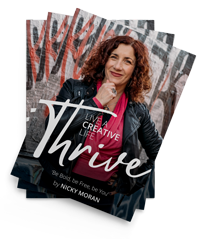I’m a creative – do I really need an elevator pitch?
“If you don’t get your pitch right, you’ll fail in business.”
I’m sure you’ve heard this kind of fear-ridden talk from self-appointed business gurus. Having a clear ‘elevator pitch’ is seen as a must-have business tool – but for creatives, it can feel so restrictive.
I’ve been on a journey to figure out why we need to have a pitch, how we can avoid sounding like everyone else and, most importantly, how to create a pitch that expresses our uniqueness.
One dreary Saturday morning 15 years ago, I’d dragged myself to a networking workshop. As a newly self-employed person, I hoped it would give me a confidence boost.
The trainer was not exactly the soft skills type. He was more of a dictator with a military style. He resembled a character from a 1970s cop show, his handlebar moustache quivering as he barked orders.
He gave us the following formula to work out a 30-second pitch: “I am a ____ who helps____ [target audience], who struggle with ___ so that they can ____.”
Then he commanded us to practise our pitch and ‘work the room’. He advised us to display confident body language and demonstrated by pushing out his chest and vigorously shaking someone’s hand.
I stood there with arms crossed, rolling my eyes like a rebellious teenager. But I also knew that I would be shouted down if I didn’t comply. Like a wooden actress, I marched around the room, reeling off my pitch over and over again with a booming voice. “Hi, I’m Nicky Moran, I’m a trainer and I help people who struggle with confidence so that they can live the life they want.” I felt awkward to say the least.
After class, I decided to abandon the script and moved into improvising, delivering a slightly different version to each person I met. I decided to simply have fun, meet new people and be myself. But over time, I realised that this approach was also limited. I had lots of conversations that didn’t go anywhere. I also began to realise that I was confusing myself. Who was I exactly?
I began to take a real interest in pitching. I was curious about why some people get lots of clients and exciting freelance jobs when others seem to be constantly on the breadline. I wondered if the answer really was as simple as a 30-second pitch.
Must we stick with the military-style formula?
In order to answer that question, I decided to look at three broad categories of creatives:
- Service providers (photographers, graphic designers, coaches, art directors)
- Product sellers (jewellery makers, printmakers, craftspeople)
- Originators (writers, composers, filmmakers, painters)
Service providers
I believe that if you provide a service such as graphic design, styling or photography then you can think like any other business. You need to define a niche. A niche helps you make it clear why you should be hired. That might mean defining your target audience and their needs – or how your style is unique and why they need some of your magic!
You can use the structure that I described at the beginning, because the emphasis is on the customer. Here are some examples – the bland version and how to spice it up.
Bland version
“I am a graphic designer who designs logos.”
Spicy versions
“I am a graphic designer who specialises in helping tech companies be more human so they can connect with more people.” (Target audience/problem you solve.)
“I am a graphic designer. My style is a bit punky/street. I love helping companies shout about what they do and stand out.” (Emphasising your signature style.)
Product sellers
If you make and sell your own work, then I think the best route for developing a pitch is to create intrigue about what you do and what you produce. Instead focusing on the customer’s needs, I would think about weaving a narrative around the unique aspects of you and your products. For example…
Bland version
“I make jewellery.”
Spicy version
“My jewellery is inspired by the Cornish coastline where I grew up. I love the shapes of the seaside and nature and with every piece, I tell a unique story inspired by its history, which you receive on parchment paper.”
Originators
You sit somewhere in between offering a service and a product and may need people to fund or commission your work. You need to create a sense of fascination so that people remember you. You can do this by describing your unique style, a story about yourself or a surprising fact. For example…
Bland versions
“I am a jazz guitarist.”
“I am a playwright based in the UK.”
Spicy versions
“I am a jazz guitarist who developed a unique style when I lived in Provence for 10 years.”
“I am playwright but I see myself as an anthropologist of misunderstandings. The knots people get themselves into when communicating fascinate me. As a youngster, my parents thought arguing was a sport. I also remember eavesdropping squabbles on the bus and learned to listen for what was being left unsaid. My plays are intended to show people a mirror of themselves, while uncovering the knots.”
So the answer to my question is: a military-style script can be a useful starting point, but other pitch structures might suit you better. Here’s one that I find useful.
Step 1 I am a (photographer, painter, jewellery maker, stylist, coach)
Step 2 + action verb (helps, paints, make films, teaches, provides, presents, creates, assists, supports, works with)
Step 3 + ideal client description (engineering firms, frustrated solo entrepreneurs, cat lovers, homeowners, professional sports people)
Step 4 + who have pain/problem (can’t fill their practice, struggle to communicate, can’t manage their time and resources effectively, can’t find the right staff, suffer from chronic back pain)
Step 5 + solution or transformation (increase their profits, feel happier, find more clients, increase their energy levels, meet their ideal partner, make money from what they’re passionate about)
Step 6 + benefits from working with you (a pain-free life, build the business of their dreams, live their life purpose, create a team that works harmoniously together)
Step 7 + emotional benefits (they are more peaceful and relaxed, have greater clarity of vision, feel more fulfilled, feel loved and cherished)
I’ve come to the conclusions that clarity is important. If you don’t have it, people won’t remember you and therefore won’t be able to recommend or refer you to anyone else. Clarity is your friend, and that’s why I would reluctantly say that the 30-second pitch still works – as long as you spice it up and use it in a creative way.
I’d love to know your thoughts – do you think elevator pitches are useful for creatives? Do you have a pitch? Leave a comment below.




